Assessment of Geothermal Resources in the North Jiangsu Basin, East China, Using Monte Carlo Simulation
Abstract
1. Introduction
2. Geologic Setting
2.1. Tectonic Evolution and Stratigraphy
2.2. Geothermal Background
2.3. Types of Geothermal Reservoir
3. Methodology
3.1. Assessment Method
3.2. Monte Carlo Simulation
4. Database
4.1. Temperature Logs
4.2. Thermal Conductivity
4.3. Input Parameters
5. Results
5.1. Simulation of the Cenozoic Sandstone Thermal Reservoirs
5.2. Simulation of the Carbonate Thermal Reservoirs
5.3. Monte Carlo Simulation Results for the Total Geothermal Resources in the North Jiangsu Basin
6. Conclusions
Author Contributions
Funding
Institutional Review Board Statement
Informed Consent Statement
Data Availability Statement
Acknowledgments
Conflicts of Interest
References
- Lund, J.W.; Boyd, T.L. Direct Utilization of Geothermal Energy 2015 Worldwide Review. Geothermics 2016, 60, 66–93. [Google Scholar] [CrossRef]
- Lund, J.W.; Freestod, D.H.; Boyd, T.L. Direct Utilization of Geothermal Energy. Geothermics 2011, 40, 159–180. [Google Scholar] [CrossRef]
- Lund, J.W.; Toth, A.N. Direct utilization of geothermal energy 2020 worldwide review. Geothermics 2021, 90, 101915. [Google Scholar] [CrossRef]
- Wang, Y.; Hu, D.; Wang, L.; Guan, J.; Bai, Y.; Wang, Z.; Jiang, G.; Hu, J.; Tang, B.; Zhu, C.; et al. The present-day geothermal regime of the North Jiangsu Basin, East China. Geothermics 2020, 88, 101829. [Google Scholar] [CrossRef]
- Min, W.; Yu, Y.; Lu, Y.; Gu, X. Assessment and zoning of geothermal resources in the northern Jiangsu Basin. Shanghai Land Resour. 2015, 36, 90–94. [Google Scholar]
- Wang, S.; Hu, J.; Yan, J.; Li, F.; Chen, N.; Tang, Q.; Guo, B.; Zhan, L. Assessment of Geothermal Resources in Petroliferous Basins in China. Math. Geol. 2019, 51, 271–293. [Google Scholar] [CrossRef]
- Zhang, W.; Wang, G.; Liu, F.; Xing, L.; Li, M. Characteristics of geothermal resources in sedimentary basins. Geol. China 2019, 46, 255–268. [Google Scholar]
- Wang, Y.; Liu, Y.; Dou, J.; Li, M.; Zeng, M. Geothermal energy in China: Status, challenges, and policy recommendations. Util. Policy 2020, 64, 101020. [Google Scholar] [CrossRef]
- Hou, J.; Cao, M.; Liu, P. Development and utilization of geothermal energy in China: Current practices and future strategies. Renew. Energy 2018, 125, 401–412. [Google Scholar] [CrossRef]
- Xu, L.; Wang, L.; Yang, Q. An Estimation of Hot-Dry-Rock (HDR) Resources in Jiangsu Province. Geol. J. China Univ. 2014, 20, 464–469. [Google Scholar]
- Zhu, J.; Hu, K.; Lu, X.; Huang, X.; Liu, K.; Wu, X. A review of geothermal energy resources, development, and applications in China: Current status and prospects. Energy 2015, 93, 466–483. [Google Scholar] [CrossRef]
- Grimmer, J.C.; Jonckheere, R.; Enkelmann, E.; Ratschbacher, L.; Hacker, B.R.; Blythe, A.E.; Wagner, G.A.; Wu, Q.; Liu, S.; Dong, S. Cretaceous−Cenozoic history of the southern Tan-Lu fault zone: Apatite fission-track and structural constraints from the Dabie Shan (eastern China). Tectonophysics 2002, 359, 225–253. [Google Scholar] [CrossRef]
- Chen, A. Tectonic features of the Subei Basin and the forming mechanism of its dustpan-shaped fault depression. Oil Gas Geol. 2010, 31, 140–150. [Google Scholar]
- Qiao, X.; Li, G.; Ming, L.; Wang, Z. CO2 storage capacity assessment of deep saline aquifers in the Subei Basin, East China. Int. J. Greenh. Gas Control 2012, 11, 52–63. [Google Scholar] [CrossRef]
- Guo, X.; Encarnacion, J.; Xu, X.; Deino, A.; Li, Z.; Tian, X. Collision and rotation of the South China block and their role in the formation and exhumation of ultrahigh pressure rocks in the Dabie Shan orogen. Terra Nova 2012, 24, 339–350. [Google Scholar] [CrossRef]
- Yin, A.; Nie, S. An indentation model for the North and South China collision and the development of the Tan-Lu and Honam Fault Systems, eastern Asia. Tectonics 1993, 12, 801–813. [Google Scholar] [CrossRef]
- Zhang, R.Y.; Liou, J.G.; Ernst, W.G. The Dabie–Sulu continental collision zone: A comprehensive review. Gondwana Res. 2009, 16, 1–26. [Google Scholar] [CrossRef]
- Chen, A. Dynamic mechanism of formation of dustpan subsidence, Northern Jiangsu. Geol. J. China Univ. 2001, 07, 408–418. [Google Scholar]
- Lu, Y.; Xu, Y.; Liu, M.; Yan, M.; Xu, S.; Lu, W. Tectonic features and evolution of the north margin of Northern Jiangsu Basin revealed by seismic reflection profile. J. Geol. 2017, 41, 624–630. [Google Scholar]
- Qian, J. Oil and gas fields formation and distribution of Subei Basin-research compared to Bohai Bay Basin. Acta Pet. Sin. 2001, 22, 12–16. [Google Scholar]
- Qiu, H.; Xu, Z.; Qiao, D. Progress in the study of the tectonic evolution of the Subei basin, Jiangsu, China. Geol. Bull. China 2006, Z2, 1117–1120. [Google Scholar]
- Zeng, P. The Application of the Thermometric Indicators to the Study of Thermal Evolution in the Lower-Yangtze Region; China University of Geosciences: Beijing, China, 2005. [Google Scholar]
- Wang, Y. Differences of Thermal Regime of the Cratons in Eastern China and Discussion of Its Deep Dynamic Mechanism; University of Chinese Academy of Sciences: Beijing, China, 2020. [Google Scholar]
- Jiang, G.; Hu, S.; Shi, Y.; Zhang, C.; Wang, Z.; Hu, D. Terrestrial heat flow of continental China: Updated dataset and tectonic implications. Tectonophysics 2019, 753, 36–48. [Google Scholar] [CrossRef]
- Lucazeau, F. Analysis and Mapping of an Updated Terrestrial Heat Flow Data Set. Geochem. Geophys. Geosyst. 2019, 20, 1–24. [Google Scholar] [CrossRef]
- Zeng, P. Comprehensive Interpretation of Large Section of G78 Area and Structural Features of Subei Basin. J. Oil Gas Technol. 2007, 29, 82–86. [Google Scholar]
- Fang, C.; Huang, Z.; Teng, L.; Xu, F.; Zhou, D.; Yin, Q.; Shao, W.S. Lithofacies palaeogeography of the Late Ordovician Kaitian Stage-the early Silurian Rhuddanian Stage in Lower Yangtze region and its petroleum geological significance. Geol. China 2020, 47, 144–160. [Google Scholar]
- Zhao, T. Structural Characteristics of Marine Mesozoic and Paleozoic and Prediction of Distribution of Their Main Assemblage in the Northern Jiangsu Area. Master’s Thesis, China University of Petroleum, Qingdao, China, 2017. [Google Scholar]
- Muffler, P.; Cataldi, R. Methods for regional assessment of geothermal resources. Geothermics 1977, 7, 53–89. [Google Scholar] [CrossRef]
- Hu, S.; He, L.; Wang, J. Heat flow in the continental area of China: A new data set. Earth Planet. Sci. Lett. 2000, 179, 407–419. [Google Scholar] [CrossRef]
- Pasquale, V.; Verdoya, M.; Chiozzi, P. Geothermics: Heat Flow in the Lithosphere; Springer: Berlin/Heidelberg, Germany, 2014; pp. 15–49. [Google Scholar]
- Wang, L.; Li, C.; Shi, Y.; Wang, Y. Distribution of geotemperature and terrestrial heat flow density in lower Yangtze area. Chin. J. Geophys. 1995, 38, 469–476. [Google Scholar]
- Wang, L.; Shi, Y. Geothermal Study on the Oil and Gas Basin; Nanjing University Press: Nanjing, China, 1989. [Google Scholar]
- Liu, J.Y.; Zhuang, D.F.; Luo, D.; Xiao, X. Land-cover classification of China: Integrated analysis of AVHRR imagery and geophysical data. Int. J. Remote Sens. 2003, 24, 2485–2500. [Google Scholar] [CrossRef]
- Engineering ToolBox. Water-Specific Heat. 2004. Available online: https://www.engineeringtoolbox.com/specific-heat-capacity-water-d_660.html (accessed on 30 December 2004).
- Yang, L. The Structural Evolution in the Cenozoic of Subei Basin and Its Relationship with Oil and Gas. Master’s Thesis, Yangtze University, Wuhan, China, 2015. [Google Scholar]
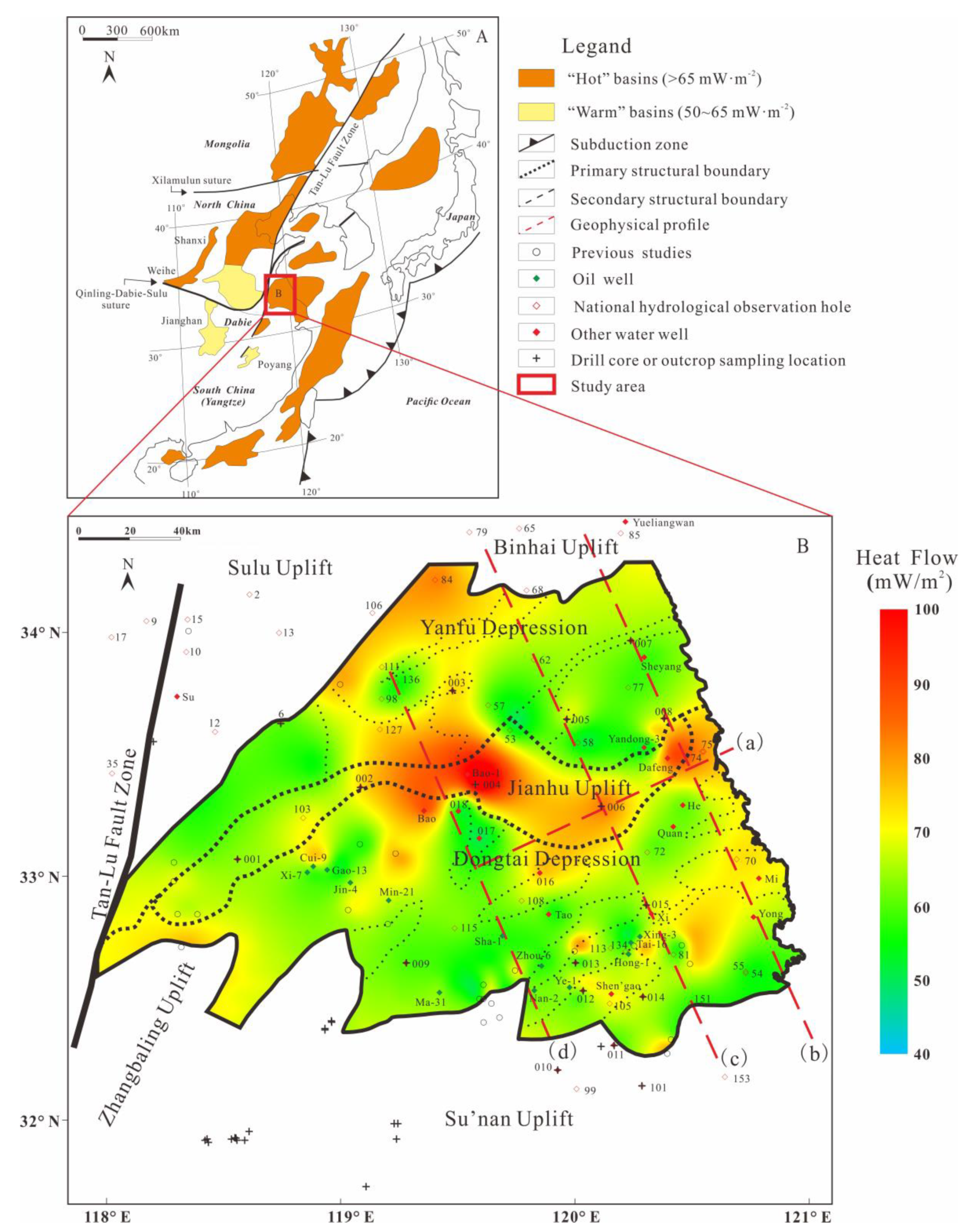
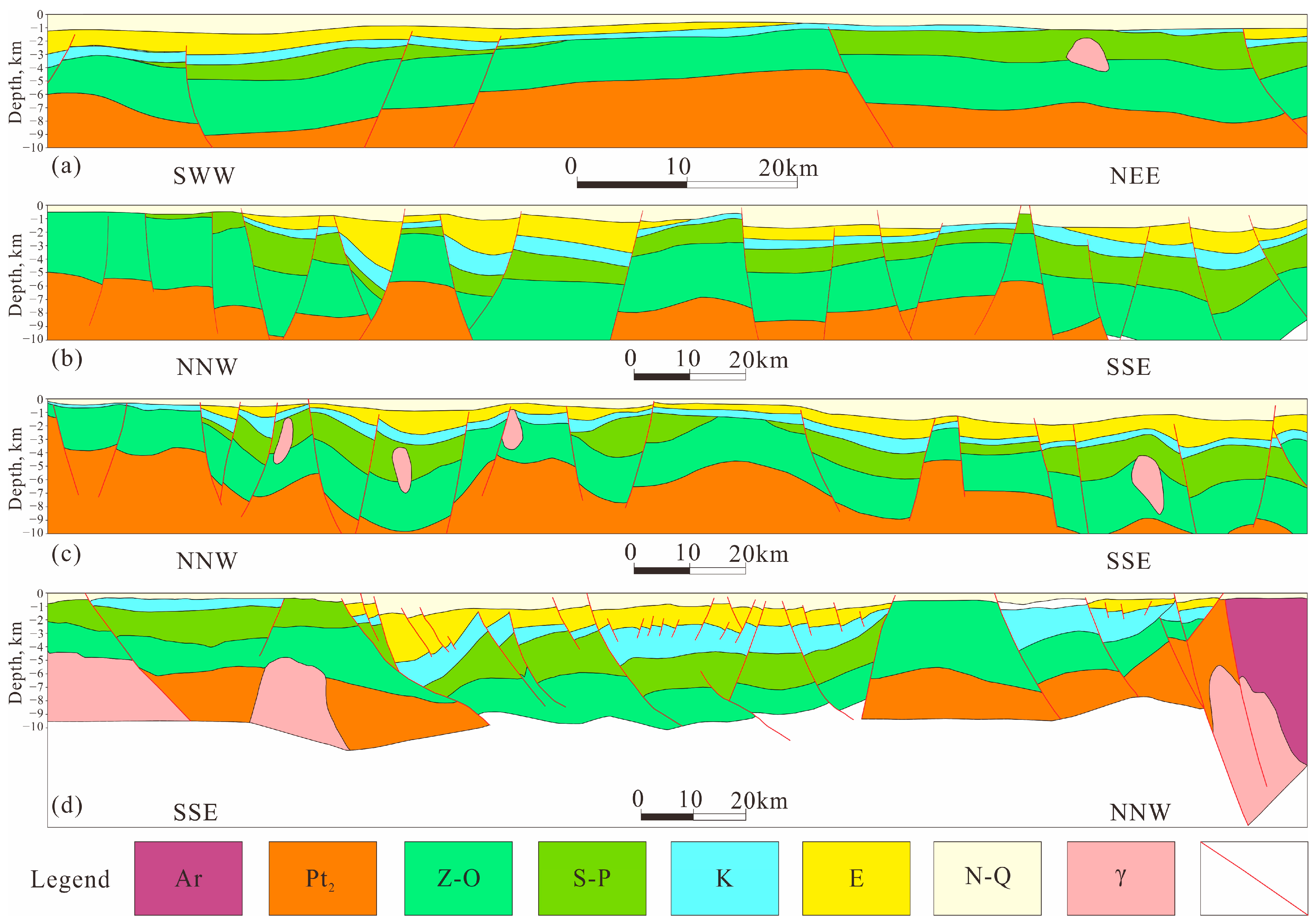

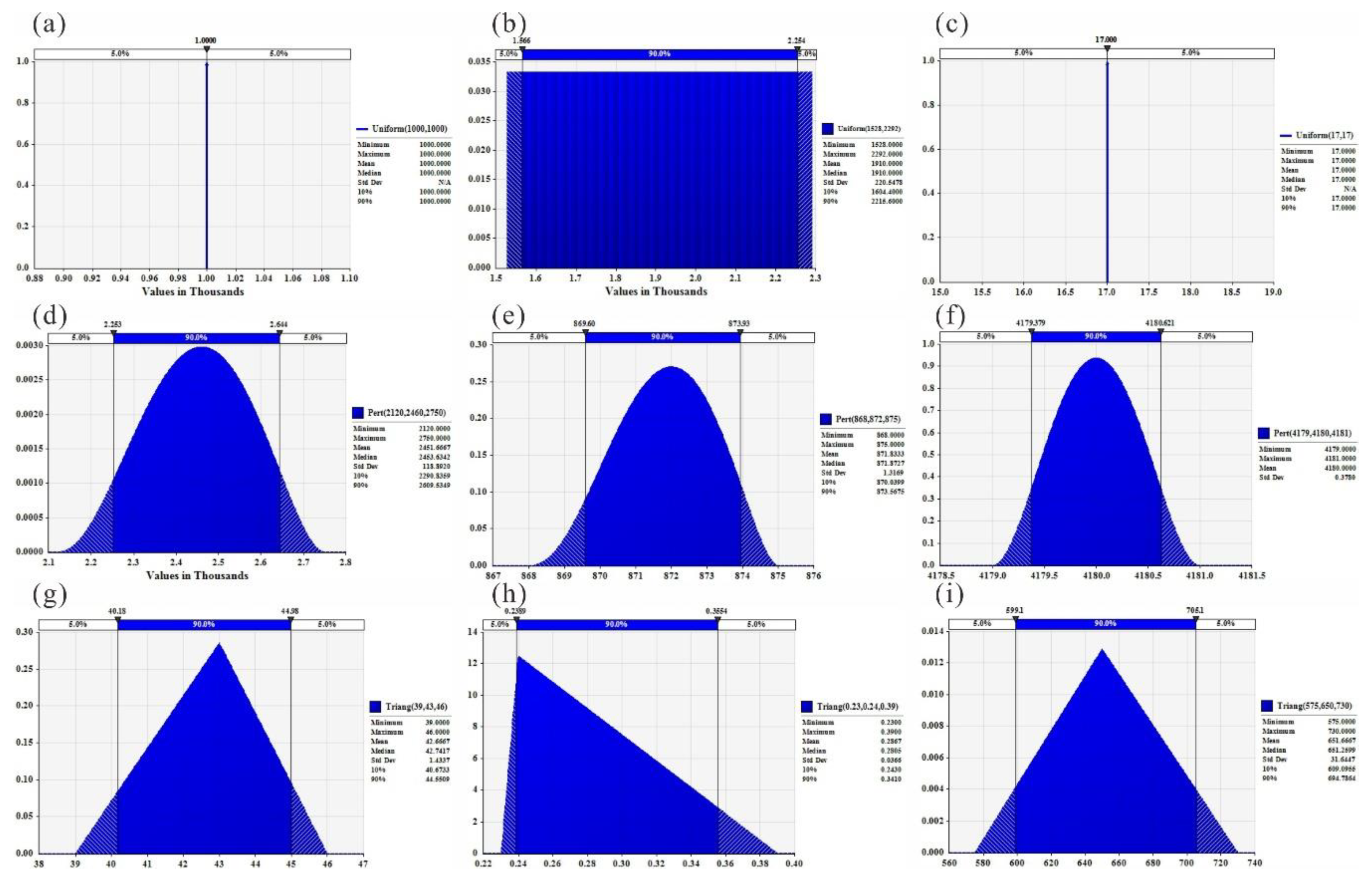

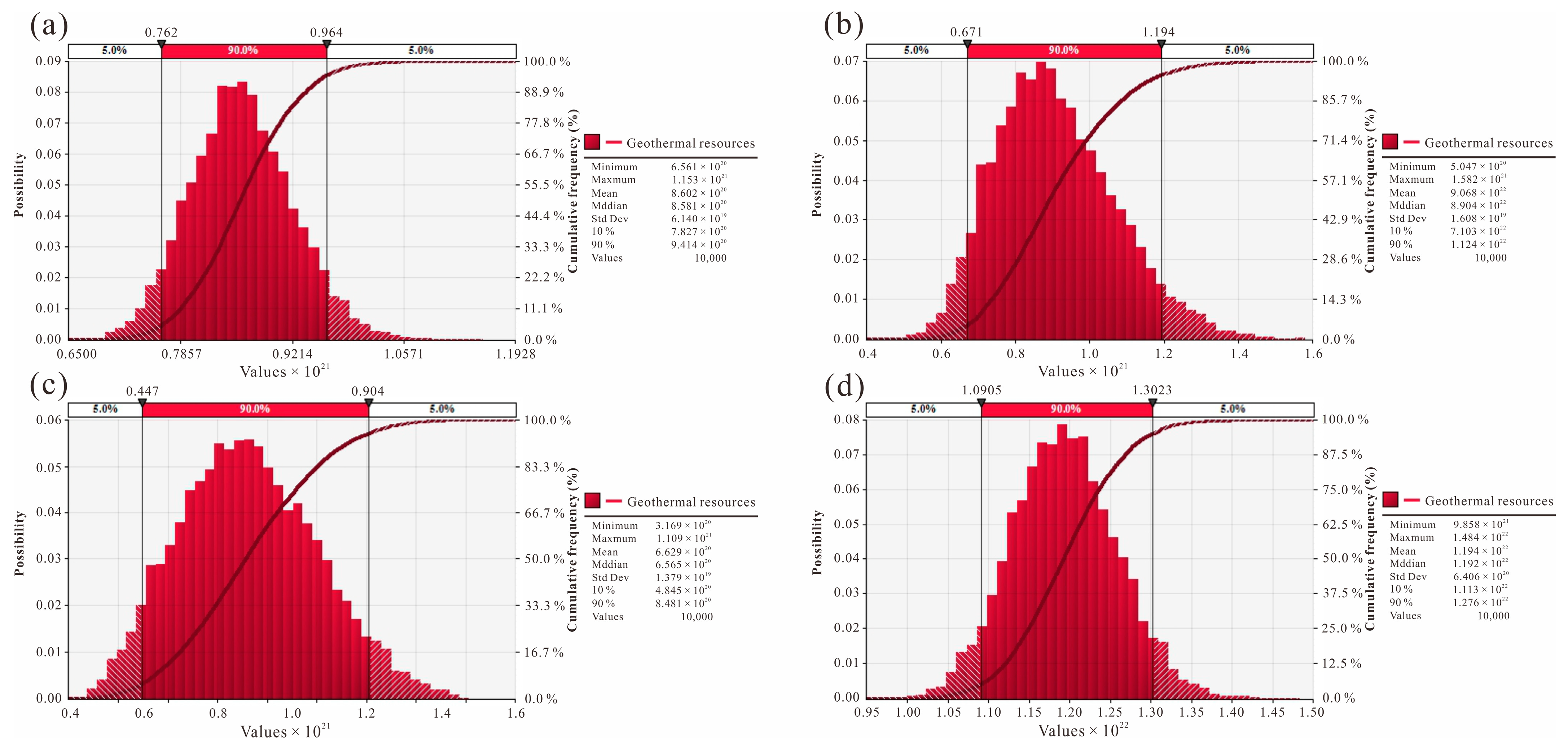
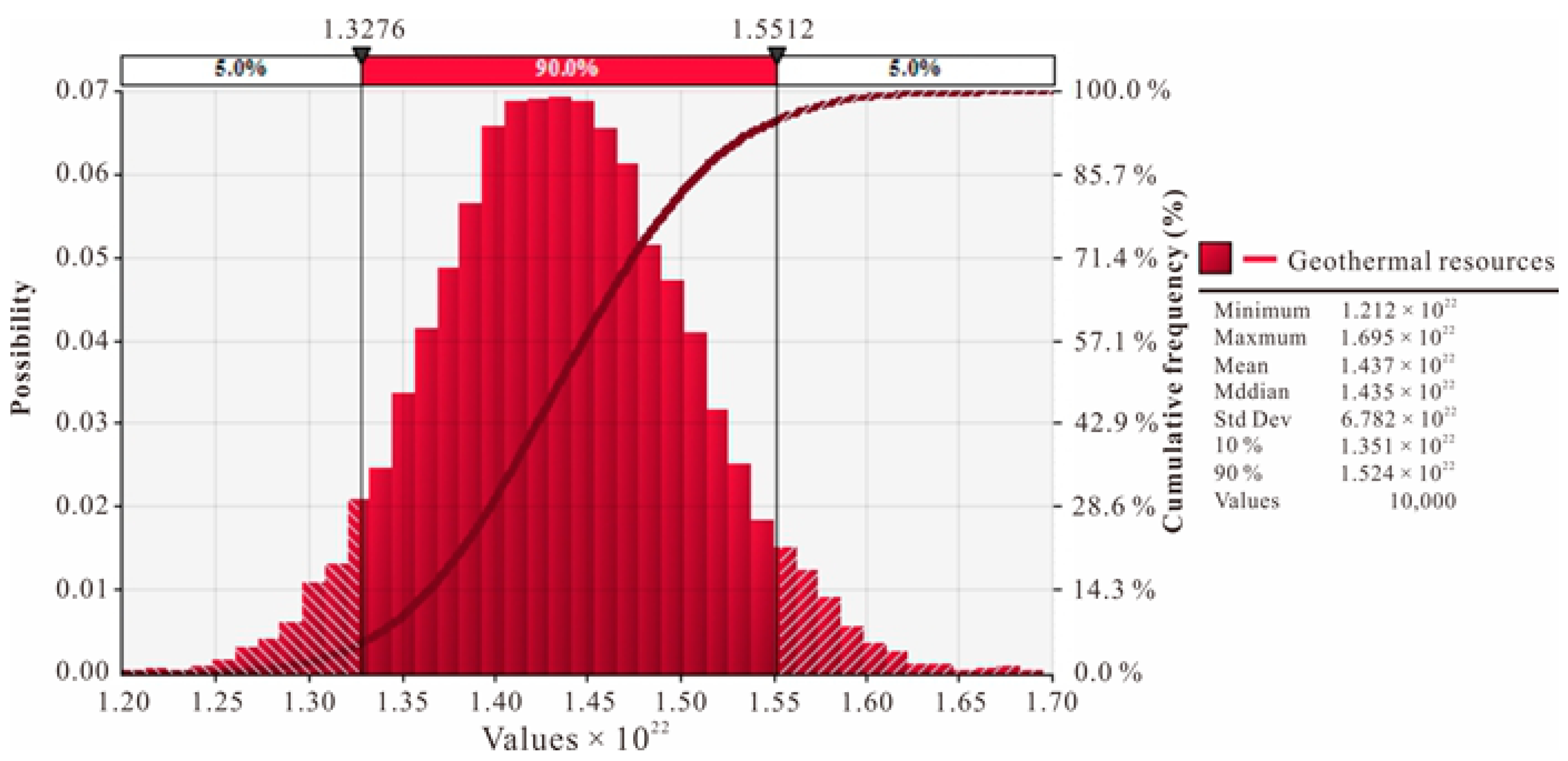
| Period | Formation | Abbreviation | Thermal Conductivity (This Work) | Thermal Conductivity (Previous Work *) | Thermal Conductivity (W·m−1·K−1) | Number | ||
|---|---|---|---|---|---|---|---|---|
| W·m−1·K−1 | Number | W·m−1·K−1 | Number | |||||
| Q | Dongtai | Q | 1.6 | 87 | 1.6 | 87 | ||
| N | Yancheng | N | 1.7 | 16 | 1.7 | 16 | ||
| E | Sanduo | E3s | 1.4 | 6 | 1.5 | 5 | 1.5 | 11 |
| Dai’nan | E2d | 2.4 | 3 | 2.4 | 7 | 2.4 | 10 | |
| Fu’ning | E4f | 1.9 | 5 | 1.9 | 5 | |||
| E3f | 2.6 | 4 | 2.6 | 4 | 2.6 | 8 | ||
| E2f | 2.4 | 5 | 2.3 | 3 | 2.4 | 8 | ||
| E1f | 2.5 | 2 | 2.5 | 6 | 2.5 | 8 | ||
| K | Taizhou | K2t | 3.0 | 1 | 2.4 | 4 | 2.6 | 5 |
| Chishan | K2c | 1.5 | 6 | 1.5 | 6 | |||
| Pukou | K2p | 2.3 | 8 | 2.4 | 10 | 2.4 | 18 | |
| K1 | 2.7 | 2 | 2.7 | 2 | ||||
| J | J | 4.4 | 4 | 2.2 | 1 | 3.9 | 5 | |
| T | T | 2.8 | 2 | 3.1 | 21 | 3.1 | 23 | |
| P | Dalong | P2d | 2.9 | 10 | 2.9 | 10 | ||
| Longtan | P2l | 2.8 | 10 | 2.5 | 6 | 2.7 | 16 | |
| Qixia | P1q | 3.3 | 3 | 3.2 | 20 | 3.2 | 23 | |
| C | Chuanshan | C3c | 3.3 | 3 | 3.3 | 6 | 3.3 | 9 |
| Huanglong | C2h | 2.8 | 2 | 3.4 | 11 | 3.4 | 13 | |
| Hezhou | C1h | 3.2 | 2 | 3.2 | 2 | 3.2 | 4 | |
| Laohudong | C1l | 5.7 | 3 | 5.7 | 3 | |||
| Gaolishan | C1g | 4.0 | 3 | 3.8 | 3 | 3.9 | 6 | |
| D | Wutong | D3w | 3.7 | 5 | 5.2 | 6 | 4.5 | 11 |
| D1+2 | 4.1 | 4 | 4.1 | 4 | ||||
| S | Maoshan | S2m1 | 8.0 | 1 | 8.0 | 1 | ||
| Fentou | S2f | 3.9 | 8 | 4.2 | 10 | 4.1 | 18 | |
| Gaojiabian | S1g | 3.3 | 17 | 3.3 | 3 | 3.3 | 20 | |
| O | - | O | 3.9 | 1 | 3.6 | 17 | 3.6 | 18 |
| Є | Guanyintai | Є3g | 3.3 | 2 | 3.3 | 2 | ||
| Paotaishan | Є3p | 4.7 | 13 | 4.7 | 13 | |||
| Mufushan | Є3m | 4.6 | 2 | 4.6 | 2 | |||
| Z | Dengying | Z2d | 6.1 | 6 | 6.1 | 6 | ||
| Huangxu | Z2h | 2.6 | 4 | 2.6 | 4 | |||
| Liantuo | Z1l | 3.8 | 1 | 3.8 | 1 | |||
| Pt | Jinping | Pt3j | 3.2 | 39 | 3.2 | 39 | ||
| Pichengyan | Pt2p | 3.4 | 18 | 3.4 | 18 | |||
| The Tectonic Units | Area (km2) | Thickness (m) | The Temperature of the Thermal Reservoir (°C) | Porosity (%) | The Density of the Rock (kg·m−3) | Specific Heat of Rock (J·kg−1·°C−1) | Water Density (kg·m−3) | Specific Heat of the Water (J·kg−1·°C−1) | The Annual Average Temperature (°C) |
|---|---|---|---|---|---|---|---|---|---|
| Hongze sag | 960~1400 (1200) | 30~240 (140) | 20~27 (23) | 23~39 (24) | 2100~2800 (2500) | 790~820 (790) | 1000 | 4200 | 15 |
| Liannan sag | 240~360 (300) | 100~300 (190) | 20~29 (24) | 23~39 (24) | 2100~2800 (2500) | 790~830 (800) | 1000 | 4200 | 16 |
| Lianbei sag | 240~360 (300) | 120~290 (200) | 20~27 (24) | 23~39 (24) | 2100~2800 (2500) | 790~820 (800) | 1000 | 4200 | 15 |
| Fu’ning sag | 1700~2200 (2200) | 100~470 (320) | 20~36 (29) | 23~39 (24) | 2100~2800 (2500) | 790~860 (830) | 1000 | 4200 | 15 |
| Yancheng sag | 1700~2100 (2100) | 320~600 (460) | 27~38 (33) | 23~39 (24) | 2100~2800 (2500) | 820~860 (850) | 1000 | 4200 | 15 |
| Huai’an high | 800~1000 (1000) | 45~120 (85) | 19~23 (21) | 23~39 (24) | 2100~2800 (2500) | 780~790 (790) | 1000 | 4200 | 17 |
| Dadong high | 40~60 (50) | 90~140 (120) | 19~21 (20) | 23~39 (24) | 2100~2800 (2500) | 780~790 (790) | 1000 | 4200 | 15 |
| Dalaba high | 320~480 (400) | 340~400 (370) | 29~32 (30) | 23~39 (24) | 2100~2800 (2500) | 730~850 (840) | 1000 | 4200 | 16 |
| Jianhu Uplift | 2100~3200 (2600) | 190~600 (300) | 25~43 (30) | 23~39 (24) | 2100~2800 (2500) | 800~870 (840) | 1000 | 4200 | 17 |
| Jinhu sag | 1500~2300 (1900) | 580~730 (650) | 39~46 (43) | 23~39 (24) | 2100~2800 (2500) | 870~880 (870) | 1000 | 4200 | 17 |
| Linze sag | 280~350 (350) | 250~450 (350) | 27~50 (38) | 23~39 (24) | 2100~2800 (2500) | 820~880 (860) | 1000 | 4200 | 17 |
| Gaoyou sag | 2100~2700 (2600) | 500~740 (620) | 43~73 (58) | 23~39 (24) | 2100~2800 (2500) | 870~900 (880) | 1000 | 4200 | 17 |
| Baiju sag | 1300~1600 (1600) | 700~960 (830) | 44~55 (49) | 23~39 (24) | 2100~2800 (2500) | 870~880 (880) | 1000 | 4200 | 16 |
| Qintong sag | 910~1100 (1100) | 390~610 (500) | 30~61 (46) | 23~39 (24) | 2100~2800 (2500) | 840~890 (880) | 1000 | 4200 | 17 |
| Hai’an sag | 3000~3800 (3800) | 550~1000 (810) | 39~57 (50) | 23~39 (24) | 2100~2800 (2500) | 870~890 (880) | 1000 | 4200 | 17 |
| Lingtangqiao high | 120~180 (150) | 370~620 (500) | 31~40 (36) | 23~39 (24) | 2100~2800 (2500) | 840~870 (860) | 1000 | 4200 | 17 |
| Liubao high | 240~300 (300) | 320~490 (405) | 27~52 (40) | 23~39 (24) | 2100~2800 (2500) | 820~880 (870) | 1000 | 4200 | 17 |
| Zheduo high | 720~900 (1200) | 390~600 (500) | 30~64 (47) | 23~39 (24) | 2100~2800 (2500) | 840~890 (880) | 1000 | 4200 | 17 |
| Wubao high | 320~400 (400) | 580~650 (610) | 38~67 (53) | 23~39 (24) | 2100~2800 (2500) | 860~890 (880) | 1000 | 4200 | 17 |
| Taizhou high | 560~730 (700) | 390~450 (420) | 28~49 (39) | 23~39 (24) | 2100~2800 (2500) | 820~880 (870) | 1000 | 4200 | 17 |
| Yuhua high | 240~300 (300) | 630~740 (680) | 42~47 (44) | 23~39 (24) | 2100~2800 (2500) | 870~880 (870) | 1000 | 4200 | 17 |
| Xiaohai high | 500~620 (620) | 310~730 (520) | 30~49 (40) | 23~39 (24) | 2100~2800 (2500) | 840~880 (870) | 1000 | 4200 | 17 |
| The Tectonic Units | Area (km2) | Thickness (m) | The Temperature of the Thermal Reservoir (°C) | Porosity(%) | The Density of the Rock (kg·m−3) | Specific Heat of Rock (J·kg−1·°C−1) | Water Density (kg·m−3) | Specific Heat of the Water (J·kg−1·°C−1) | The Annual Average Temperature (°C) |
|---|---|---|---|---|---|---|---|---|---|
| Hongze sag | 1400~1800 (1800) | 250~980 (610) | 38~72 (55) | 23~28 (27) | 2300~2800 (2500) | 870~900 (880) | 1000 | 4200 | 15 |
| Lianbei sag | 240~360 (300) | 400~600 (500) | 43~53 (48) | 23~28 (27) | 2300~2800 (2500) | 870~880 (880) | 1000 | 4200 | 15 |
| Fu’ning sag | 750~1130 (940) | 0~500 (260) | 25~50 (43) | 23~28 (27) | 2300~2800 (2500) | 840~880 (870) | 1000 | 4200 | 15 |
| Yancheng sag | 1600~2100 (1900) | 360~400 (380) | 48~51 (50) | 23~28 (27) | 2300~2800 (2500) | 870~880 (880) | 1000 | 4200 | 15 |
| Jinhu sag | 4000~5000 (5000) | 300~1100 (500) | 36~87 (72) | 23~28 (27) | 2300~2800 (2500) | 860~920 (900) | 1000 | 4200 | 17 |
| Linze sag | 240~350 (300) | 0~350 (100) | 50~55 (52) | 23~28 (27) | 2300~2800 (2500) | 880~890 (880) | 1000 | 4200 | 17 |
| Gaoyou sag | 160~280 (250) | 160~280 (250) | 70~89 (80) | 23~28 (27) | 2300~2800 (2500) | 900~920 (910) | 1000 | 4200 | 17 |
| Baiju sag | 230~340 (280) | 0~350 (100) | 55~57 (56) | 23~28 (27) | 2300~2800 (2500) | 880~890 (890) | 1000 | 4200 | 16 |
| Qintong sag | 910~1100 (1100) | 100~350 (300) | 49~74 (60) | 23~28 (27) | 2300~2800 (2500) | 880~910 (890) | 1000 | 4200 | 17 |
| Hai’an sag | 3000~3800 (3800) | 50~800 (200) | 59~63 (61) | 23~28 (27) | 2300~2800 (2500) | 890 | 1000 | 4200 | 17 |
| Lingtangqiao high | 360~450 (450) | 150~450 (250) | 42~47 (45) | 23~28 (27) | 2300~2800 (2500) | 870~880 (870) | 1000 | 4200 | 17 |
| Liubao high | 240~300 (300) | 0~300 (100) | 42~54 (45) | 23~28 (27) | 2300~2800 (2500) | 870~880 (870) | 1000 | 4200 | 17 |
| Zheduo high | 680~900 (850) | 50~300 (100) | 55~65 (58) | 23~28 (27) | 2300~2800 (2500) | 880~890 (890) | 1000 | 4200 | 17 |
| Wubao high | 320~400 (400) | 200~280 (240) | 62~81 (72) | 23~28 (27) | 2300~2800 (2500) | 890~910 (900) | 1000 | 4200 | 17 |
| The Tectonic Units | Area (km2) | Thickness (m) | The Temperature of the Thermal Reservoir (°C) | Porosity (%) | The Density of the Rock (kg·m−3) | Specific Heat of Rock (J·kg−1·°C−1) | Water Density (kg·m−3) | Specific Heat of the Water (J·kg−1·°C−1) | The Annual Average Temperature (°C) |
|---|---|---|---|---|---|---|---|---|---|
| Hongze sag | 1400~1800 (1800) | 250~540 (390) | 63~74 (67) | 16~29 (24) | 2700~2800 (2700) | 890~910 (900) | 1000 | 4200 | 15 |
| Lianbei sag | 200~300 (250) | 200~400 (300) | 54~61 (58) | 16~29 (24) | 2700~2800 (2700) | 880~890 (890) | 1000 | 4200 | 15 |
| Fu’ning sag | 200~500 (400) | 0~340 (270) | 45~55 (52) | 16~29 (24) | 2700~2800 (2700) | 870~880 (880) | 1000 | 4200 | 15 |
| Yancheng sag | 280~420 (350) | 250~470 (360) | 57~63 (60) | 16~29 (24) | 2700~2800 (2700) | 890 | 1000 | 4200 | 15 |
| Jinhu sag | 3300~4200 (4000) | 100~600 (350) | 106~120 (113) | 16~29 (24) | 2700~2800 (2700) | 950~990 (970) | 1000 | 4200 | 17 |
| Gaoyou sag | 1800~2200 (2600) | 190~250 (220) | 74~90 (81) | 16~29 (24) | 2700~2800 (2700) | 910~930 (910) | 1000 | 4200 | 17 |
| Qintong sag | 340~430 (520) | 0~330 (250) | 60~80 (67) | 16~29 (24) | 2700~2800 (2700) | 890~900 (900) | 1000 | 4200 | 17 |
| Hai’an sag | 190~290 (240) | 50~300 (100) | 60~66 (63) | 16~29 (24) | 2700~2800 (2700) | 890~900 (890) | 1000 | 4200 | 17 |
| Wubao high | 40~60 (50) | 150~200 (170) | 70~78 (74) | 16~29 (24) | 2700~2800 (2700) | 900~910 (910) | 1000 | 4200 | 17 |
| The Tectonic Units | Area (km2) | Thickness (m) | The Temperature of the Thermal Reservoir (°C) | Porosity (%) | The Density of the Rock (kg·m−3) | Specific Heat of Rock (J·kg−1·°C−1) | Water Density (kg·m−3) | Specific Heat of the Water (J·kg−1·°C−1) | The Annual Average Temperature (°C) |
|---|---|---|---|---|---|---|---|---|---|
| Hongze sag | 900~1400 (1100) | 1000~2000 (1500) | 130~170 (160) | 0.5~6 (2) | 2700~2900 (2800) | 950~970 (960) | 1000 | 4300 | 15 |
| Liannan sag | 550~880 (660) | 1000~1900 (1500) | 92~120 (110) | 0.5~6 (2) | 2700~2900 (2800) | 920~940 (930) | 1000 | 4200 | 16 |
| Lianbei sag | 400~640 (480) | 1400~1900 (1700) | 110~140 (120) | 0.5~6 (2) | 2700~2900 (2800) | 930~950 (940) | 1000 | 4200 | 15 |
| Fu’ning sag | 1100~1700 (1300) | 900~2400 (1800) | 76~220 (160) | 0.5~6 (2) | 2700~2900 (2800) | 900~990 (960) | 1000 | 4300 | 15 |
| Yancheng sag | 1100~1700 (1300) | 1500~2500 (2000) | 170~210 (190) | 0.5~6 (2) | 2700~2900 (2800) | 970~980 (980) | 1000 | 4400 | 15 |
| Huai’an high | 500~800 (600) | 620~1600 (1100) | 62~96 (79) | 0.5~6 (2) | 2700~2900 (2800) | 890~920 (910) | 1000 | 4200 | 17 |
| Dadong high | 130~200 (150) | 1800~2200 (2000) | 54~99 (77) | 0.5~6 (2) | 2700~2900 (2800) | 880~920 (900) | 1000 | 4200 | 15 |
| Dalaba high | 200~320 (240) | 2300~2500 (2400) | 62~100 (83) | 0.5~6 (2) | 2700~2900 (2800) | 890~930 (910) | 1000 | 4200 | 16 |
| Jianhu Uplift | 2200~3500 (2600) | 1000~2100 (1600) | 25~160 (94) | 0.5~6 (2) | 2700~2900 (2800) | 840~960 (920) | 1000 | 4200 | 17 |
| Jinhu sag | 2500~4000 (3000) | 1500~1800 (1700) | 140~180 (160) | 0.5~6 (2) | 2700~2900 (2800) | 950~970 (960) | 1000 | 4300 | 17 |
| Linze sag | 180~280 (210) | 1700~2700 (2200) | 100~160 (130) | 0.5~6 (2) | 2700~2900 (2800) | 930~970 (950) | 1000 | 4300 | 17 |
| Gaoyou sag | 1300~2100 (1600) | 1400~1800 (1600) | 130~160 (140) | 0.5~6 (2) | 2700~2900 (2800) | 940~970 (960) | 1000 | 4300 | 17 |
| Baiju sag | 800~1300 (960) | 1500~1800 (1700) | 130~180 (150) | 0.5~6 (2) | 2700~2900 (2800) | 950~970 (960) | 1000 | 4300 | 16 |
| Qintong sag | 570~910 (680) | 1400~2300 (1900) | 100~180 (140) | 0.5~6 (2) | 2700~2900 (2800) | 930~970 (960) | 1000 | 4300 | 17 |
| Hai’an sag | 1900~3000 (2300) | 1600~2100 (1900) | 180~230 (200) | 0.5~6 (2) | 2700~2900 (2800) | 970~990 (980) | 1000 | 4500 | 17 |
| Lingtangqiao high | 230~360 (270) | 1000~1800 (1500) | 120~170 (150) | 0.5~6 (2) | 2700~2900 (2800) | 940~970 (960) | 1000 | 4300 | 17 |
| Liubao high | 150~240 (180) | 1600~2300 (2000) | 88~140 (110) | 0.5~6 (2) | 2700~2900 (2800) | 910~950 (930) | 1000 | 4200 | 17 |
| Zheduo high | 450~720 (540) | 760~1700 (1200) | 84~120 (100) | 0.5~6 (2) | 2700~2900 (2800) | 910~940 (920) | 1000 | 4200 | 17 |
| Wubao high | 200~320 (240) | 1300~1500 (1400) | 110~150 (130) | 0.5~6 (2) | 2700~2900 (2800) | 930~960 (950) | 1000 | 4300 | 17 |
| Taizhou high | 370~590 (440) | 1300~1500 (1400) | 81~120 (100) | 0.5~6 (2) | 2700~2900 (2800) | 910~940 (930) | 1000 | 4200 | 17 |
| Yuhua high | 150~240 (180) | 1600~2300 (1900) | 130~170 (150) | 0.5~6 (2) | 2700~2900 (2800) | 950~970 (960) | 1000 | 4300 | 17 |
| Xiaohai high | 310~500 (370) | 1500~1700 (1600) | 92~140 (120) | 0.5~6 (2) | 2700~2900 (2800) | 920~950 (940) | 1000 | 4200 | 17 |
Publisher’s Note: MDPI stays neutral with regard to jurisdictional claims in published maps and institutional affiliations. |
© 2021 by the authors. Licensee MDPI, Basel, Switzerland. This article is an open access article distributed under the terms and conditions of the Creative Commons Attribution (CC BY) license (http://creativecommons.org/licenses/by/4.0/).
Share and Cite
Wang, Y.; Wang, L.; Bai, Y.; Wang, Z.; Hu, J.; Hu, D.; Wang, Y.; Hu, S. Assessment of Geothermal Resources in the North Jiangsu Basin, East China, Using Monte Carlo Simulation. Energies 2021, 14, 259. https://doi.org/10.3390/en14020259
Wang Y, Wang L, Bai Y, Wang Z, Hu J, Hu D, Wang Y, Hu S. Assessment of Geothermal Resources in the North Jiangsu Basin, East China, Using Monte Carlo Simulation. Energies. 2021; 14(2):259. https://doi.org/10.3390/en14020259
Chicago/Turabian StyleWang, Yibo, Lijuan Wang, Yang Bai, Zhuting Wang, Jie Hu, Di Hu, Yaqi Wang, and Shengbiao Hu. 2021. "Assessment of Geothermal Resources in the North Jiangsu Basin, East China, Using Monte Carlo Simulation" Energies 14, no. 2: 259. https://doi.org/10.3390/en14020259
APA StyleWang, Y., Wang, L., Bai, Y., Wang, Z., Hu, J., Hu, D., Wang, Y., & Hu, S. (2021). Assessment of Geothermal Resources in the North Jiangsu Basin, East China, Using Monte Carlo Simulation. Energies, 14(2), 259. https://doi.org/10.3390/en14020259





